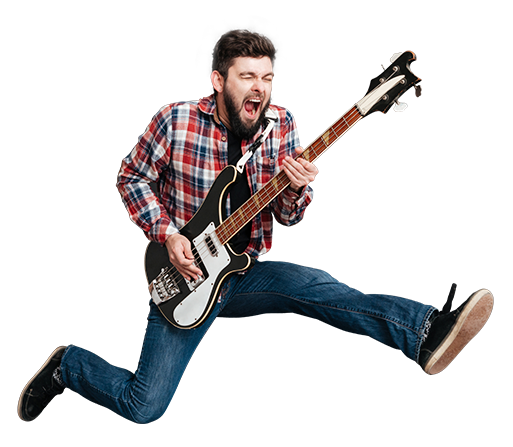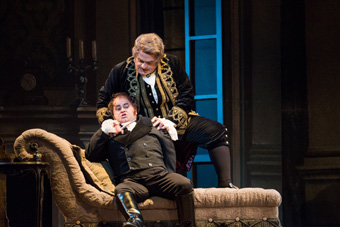
Photographer: Justin Namon
Todd Thomas and Jason Ferrante
Puccini’s opera, with an Italian libretto by Luigi Illica and Giuseppe Giacosa, was adapted from Victorien Sardou’s wildly successful play, La Tosca, a game of psychological chess where all the main characters wind up at checkmate.
Puccini had turned his attention away from the intrigues of history and mythology as subject matter, to the verismo style – the realistic depiction of the many sides of real life – a reaction to operatic conventions which were considered artificial and unrealistic.
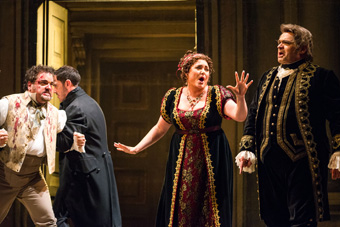
Photographer: Justin Namon
Rafael Davila, Kara Shay Thomson and Todd Thomas
Tosca is scored as a through-composed work, with arias, recitative, choruses and instrumental elements musically stitched together into whole cloth. It is driven by action, not “atmosphere.” Puccini employed Short musical statements (leitmotifs) to identify specific characters, objects and ideas, as reminders within the narrative. Motifs are often subtle, almost subliminal, identifying, for example, Tosca herself, the love between her and her lover Cavaradossi, even the theme of torture in Act 2. The decidedly recognizable theme for the evil Scarpia is the most potent of these motifs – a sequence of three severe chords which open the opera in lieu of an overture – setting the violent tempo of the story.
The love story between Tosca and Cavaradossi, and Scarpia’s tyranny and lechery, "the dynamic engine that ignites the drama," is set against the backdrop of Rome falling to Napoleon during his invasion of Italy in June 1800. Puccini’s mastery of the orchestra, spectacularly wrapping the music around the text with bold harmonic progressions, gives opportunities to its three leading characters to shine.
Rafael Davila (alternating with Diego Torre) as Tosca’s lover, Mario Cavaradossi, gave us a first glimpse of his powerful tenor with "Recondita armonia," musing on the "strange harmonies" between his painting of a Madonna for the church and his love for Tosca. He handled the familiar aria with apparently effortless command, earning the high B flat money note and the audience’s appreciation for it. Though stiff as an actor, an unfortunate tradition with many operatic performers, Davila rang true in his arias and duets, most notably wringing the bulging emotion from the "E lucevan le stelle," as he writes his final letter to Tosca before his “mock” execution in Act 3.
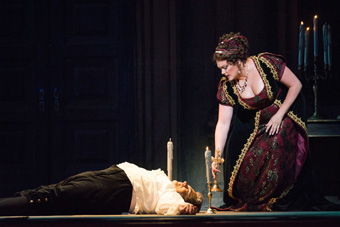
Photographer: Justin Namon
Todd Thomas and Kara Shay Thomson
Kara Shay Thomson (alternating with Jouvanca Jean-Baptiste) as Floria Tosca, duetted well vocally with Davila, though the chemistry between them as lovers was regretfully absent. Thomson, a consummate lyric-spinto soprano (lyric voice with a dramatic element), sang lively and sweetly of their little house, "Non la sospiri, la nostra casetta." After Tosca questioned the woman in Cavaradossi’s painting, the pair connected well with the sensuous love duet, "Qual’occhio," Davila launching his high register almost ecstatically, he and Thomson blending their voices in a satisfying rapture. Tosca suggested with a velvet fist that Cavaradossi change the color of his Madonna’s blue eyes to match her darker ones.
The most fully realized character was in the dramatically charged performance of Todd Thomas as the smarmy Chief of Police, Baron Scarpia. With greyish slicked back hair, the tall and husky Thomas was a menacing presence, dripping with evil. He was as oily as it gets when he presented Tosca with a lady’s fan (an Iago handkerchief moment!) to convince Tosca that Cavaradossi was being unfaithful to her. Scarpia congratulated himself ("Va, Tosca!") on his future successes, Tosca his prize.
A musical highpoint was “Te Deum laudamus,” juxtapositioning the sacred and the profane. Thomas’s big baritone voice, rich in color and texture, eerily rendered Scarpia’s lustful reverie in counterpoint to the swelling sacred music praising God. Thomas’s baritone matched the size of the full orchestra and chorus – magnificent with bells tolling, a church organ, and the strings ascending – joining the unison and dropping to one knee as he proclaimed, “Tosca, you make me forget God!”
Puccini’s construction of one of opera’s most macabre scenes begins with Scarpia arrogantly musing on the imminent downfall of Cavaradossi (“Ha piu forte sapore”), commenting on the “joy of conquest and how it goes beyond the pleasure of romance.” The scene’s suspense grows darker, Puccini’s score ever expanding, as Scarpia, with the help of his right-hand-man Spoletta (creepy tenor Jason Ferrante), leads the interrogation and torture of Cavaradossi. Cavaradossi claimed that he did not know where the fugitive Angelotti (ragged bass Adam Lau) was hiding, the orchestra blowing Cavaradossi’s cover by repeating the ‘garden well’ motif played earlier when Cavaradossi told Angelotti to hide in the well.
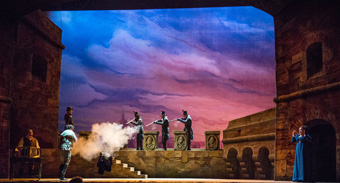
Photographer: Justin Namon
Firing squad pointing at Rafael Davila while Kara Shay Thomson looks on
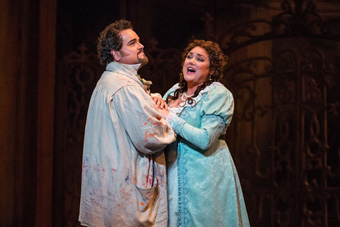
Photographer: Justin Namon
Rafael Davila and Kara Shay Thomson
Thomas delivered his slimy soft side, his voice almost sympathetic with “Gia mi dicon venal,” a response to Tosca’s offer of a bribe. Scarpia requested an hour of her time after which she could have Cavaradossi for eternity. Tosca realized what she must do.
Puccini freezes the action as the showstopper “Vissi d’arte” commences, Tosca taking it to God, declaiming she’s lived for art, lived for love, and never harmed a living creature, asking God why, in her hour of sorrow, rewards her thus? Thomson’s rich round notes against Puccini’s melodic backdrop made this truly a Job moment, wrought with anguish, passion and pathos, her voice penetrating to the bone. Even the most stoic members of the audience were served.
Thomson now fully realized in her character, drove a knife into Scarpia’s chest, grippingly exclaiming, “Here is the kiss of Tosca!” laying a cross on Scarpia’s chest as the final notes of the act (the Scarpia motif) was now softly rendered in a minor key..
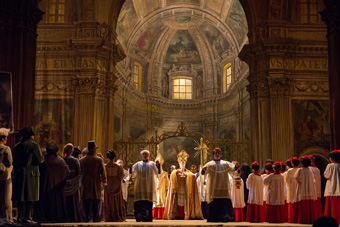
Photographer: Justin Namon
Group/Chorus
Lighting designer Christopher Maravich lit this scene effectively, moonlight shining through the window as the contemplating Scarpia looked out while Tosca questioned God; pale blue light saturated the stage with a downlight on The dead body of Scarpia, rich amber light flooding in through the door as Tosca opened it to leave, looking back over her shoulder at him and returning to place the cross on his sunken chest.
Credit Puccini for staying with “Vissi d’arte.” He considered eliminating it since it held up the action – sort of like MGM chief Louis Mayer and producer Mervyn LeRoy both wanting Somewhere Over the Rainbow removed from The Wizard Of Oz because they felt it slowed down the movie
The concluding act found a melancholy clarinet stating the theme for "E lucevan le stelle," Davila delivering the famed farewell to love and life lament with abject despair, a full heart, and vivid vocals. Davila later sang ardently of Tosca’s sweet hands (“O dolci mani"), hands that were made for caressing children having murdered the most powerful man in Rome. He joined Thomson in their final duet, their voices, particularly in their unison, delivered "Amaro sol per te m’era il morire" with strong hearts and pipes.
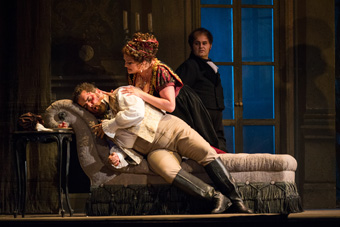
Photographer: Justin Namon
Rafael Davila, Kara Shay Thomson and Jason Ferrante
The execution of Cavaradossi and Tosca leaping to her death remain the poster child of tragic opera.
The impact of the FGO Orchestra under maestro Tebar continued to reign supreme, embracing every note of Puccini’s score with intensity and finesse.
Other characters included baritone Andrew Funk as the comical sacristan, bass Dennis Ryan as the Jailer, and alto Caden Barr, the Shepherd Boy (singing the morning song, “Io de’ sospiri”).
The production team included Conductor Tebar; stage director José Maria Condemi; chorus master Michael Sakir; lovely gowns and velvet robes and costumes by Malabar; sets by Ercole Sormani (actual locations in Rome were painted drops created for Seattle Opera nearly fifty years ago).
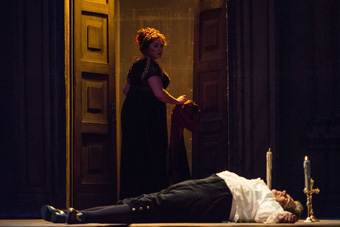
Photographer: Justin Namon
Kara Shay Thomson and Todd Thomas
Tosca, the first major opera of the 20th century, has remained on opera’s most performed top 10 list since its premiere in January 1900, continuing to fascinate audiences and performers.
Justin Moss, Director of FGO’s Broward Operations, suggested that Tosca was a good choice as somebody’s first opera. “If there’s somebody you know who’s never been to the opera,” Moss mused, “drag them to Tosca. If they don’t respond, you may want to reevaluate your friendship.”
Sung in Italian with projected titles in English and Spanish
Miami Adrienne Arsht Center for the Performing Arts / Ziff Ballet Opera House
April 4 & 5, 2014, at 8:00 p.m.
Fort Lauderdale Broward Center for the Performing Arts / Au-Rene Theater
April 10 & 12, 2014, at 7:30 p.m.
www.FGO.org
 MAIN MENU
MAIN MENU

